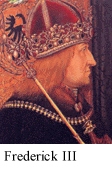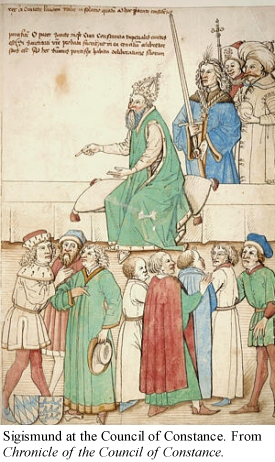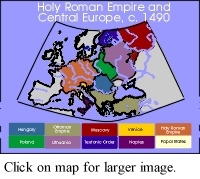The End of Europe's Middle Ages
The Holy Roman Empire (HRE) was faced with many difficulties during the later Middle Ages. The vast distances between territorial holdings, extreme regional disparities, ethnic complexities, and the lack of a strong hereditary kingship prevented the consolidation and centralisation of authority that characterised the New Monarchies of England, France, and Spain. Internal dissension and longstanding disputes with the papacy and France forced German kings to choose between maintaining control within their empire and enhancing the international prestige of the imperial crown.
A political empire imposed across geographic and ethnic boundaries, at the start of the fourteenth century, the Holy Roman Empire was comprised of present-day Germany and extended across Prussia, Hungary, Bohemia, Switzerland, and parts of southern and northern Italy. Literally hundreds of smaller principalities, duchies, and counties composed the empire. Succession to the imperial title required two steps. First, a candidate was selected by the German princes and elected king of Germany. Next, imperial recognition and coronation had to be granted by the pope. Not every elected king became emperor and many German kings did not even seek the imperial title.
 |
Origins of the Holy Roman Empire |
In an attempt to eliminate papal interference from German politics, Louis IV (1287-1347), in association with German princes, issued the
Declaration of Rense in 1338 that stated that the emperor would be elected by an electoral college of German princes and that papal confirmation was unnecessary. Pope Clement VI (1291-1352) resented Louis IV's exclusionary tactics and formally deposed the emperor in 1346, promoting a former student, Charles of Luxembourg (1316-1378), in Louis IV's place.
The pope's candidate was not immediately accepted but, following Louis IV's death in 1347, Charles ascended to the throne as Charles IV.
Charles IV's strong ties with Bohemia led him to focus on that country but he also sought to regularise laws and governmental practices throughout the empire. In 1356, he issued the "Golden Bull" which was a key step towards standardising electoral procedures. The Bull clearly set out the seven officials who were in the college of electors. The seven electors included three princes of the Church - the archbishops of Mainz, Triers, and Cologne - and four lay princes - the King of Bohemia, the Count Palatine of Rhine, the Margrave of Brandenburg, and the Duke of Saxony. The lay offices eventually acquired 'quasi-sovereign' powers including judicial independence, the right to mint money, the right to collect tolls, and various mining privileges. In effect, the electorates became autonomous and established a paradigm of power that non-electoral princes also claimed.
 |
Golden Bull of 1356 |
Meanwhile, Charles IV concerned himself with acquiring lands and securing the imperial title for his family. He had the Electorate designate his son, Wenzeslaus (1361-1419), as his successor before his death in 1378. Wenzeslaus was better known as a lover of wine than an effective ruler and spent his entire reign in Bohemia. The rest of the kingdom resented his incompetence and neglect. In 1400, the Electors deposed Wenzeslaus and elevated Rupert of the Palatinate to the throne.
The validity of Rupert's claim was disputed from the start and another election in 1411 selected another of Charles IV's sons. Unfortunately, Sigismund (1368-1437) was another weak king. Although he was unable to protect his empire's frontiers from Turkish invaders or to deal with religious dissension from the
Hussites within his kingdom, Sigismund was instrumental in resolving the
Great Schism in 1414 at the
Council of Constance. When Sigismund failed to produce a male heir, he arranged a marriage between his daughter and a Habsburg prince, Albert (1397-1439). As Albert II, he was recognised as Holy Roman Emperor but his one-year reign was too brief to allow him to be formally crowned.
 |
Hussitism |

|
In 1440, the Electors chose another Habsburg, Frederick III (1415-1493), who was the last emperor to be crowned at Rome by the pope. During a long and relatively uneventful reign, Frederick III established a dynastic policy that was aimed at creating a network of marriage alliances across Europe. His tactics are best expressed in his own words: "Let others lead wars; you, happy Austria, marry!" Although Frederick III was not particularly competent as a ruler, his marriage strategy proved successful. The Habsburgs were soon allied with most of Europe's ruling houses and the imperial title of Holy Roman Emperor became a dynastic title rather than an elected one. The imperial office would remain with the Habsburgs until its abolition in 1806 even though the male line died out in 1740. |
 |
Habsburgs |
The last emperor of the late Middle Ages was Maximilian I of Habsburg (1459-1519) who expanded the Holy Roman Empire and firmly established the Habsburg dynasty as a European power. He successfully defended both his territories in northern Italy and his wife's Burgundian lands against French incursions. Maximilian I applied his father's marriage strategies to good effect, bringing the kingdoms of Aragón and Castile into the Habsburg hegemony when he married his son Philip to Joanna the Mad of Spain.
Despite two centuries of relatively ineffective rulers, the Holy Roman Empire had been able to re-establish some degree of international political power by the end of the late Middle Ages. However, it had failed both to secure political unity amongst its many tiny principalities or to establish a strong centralised government, such as those in England, France, and Spain.
 |
Return to New Monarchies | Proceed to Italy's City-States |  |
The End of Europe's Middle Ages / Applied History Research Group / University of Calgary
Copyright © 1998, The Applied History Research Group


